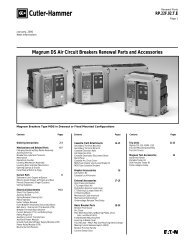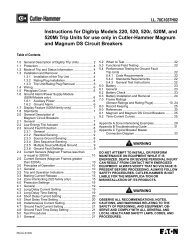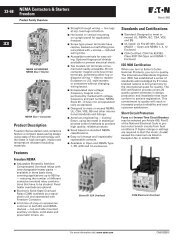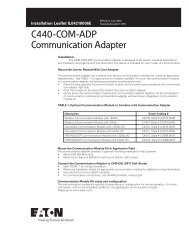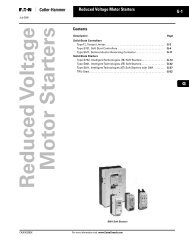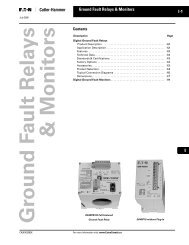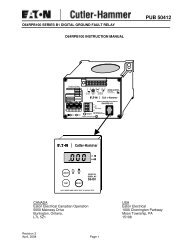Control/GF/Voltage Relays & Pilot - Eaton
Control/GF/Voltage Relays & Pilot - Eaton
Control/GF/Voltage Relays & Pilot - Eaton
You also want an ePaper? Increase the reach of your titles
YUMPU automatically turns print PDFs into web optimized ePapers that Google loves.
September 2011<br />
Sheet 32021<br />
D65 Series<br />
D65 Series<br />
General Description<br />
The <strong>Eaton</strong> D65 voltage monitoring<br />
relay protects distribution systems<br />
supplying motor feeder or branch<br />
circuits against premature equipment<br />
failure caused by voltage problems on<br />
wye or delta connected three-phase<br />
systems. <strong>Voltage</strong> monitoring relays<br />
protect against voltage imbalance<br />
and single-phasing regardless of any<br />
regenerative voltages. The relay is<br />
energized when the phase sequence<br />
and all voltages are correct. Any<br />
of five abnormal conditions (phase<br />
loss, phase reversal, overvoltage,<br />
undervoltage or phase imbalance)<br />
will de-energize the relay. As standard,<br />
re-energization is automatic upon<br />
correction of the fault condition. The<br />
D65 can also be wired for manual reset.<br />
Application Description<br />
Protective Functions<br />
The D65 Series relay makes separate<br />
trip decisions based on the status of<br />
the three-phase voltage inputs. <strong>Control</strong><br />
power is derived from the three-phase<br />
voltage inputs. Separate control power<br />
is not required. The device will trip in<br />
response to any combination of the<br />
following conditions:<br />
■ Undervoltage—When voltage in all<br />
three lines of a three-phase system<br />
drops simultaneously. Undervoltage<br />
dropout can be set at 80–95% of<br />
operating voltage. Unit trips when<br />
the average of all three lines is less<br />
than the adjusted set point for a<br />
period longer than the adjustable<br />
time delay dropout (0.1–20 seconds).<br />
This time delay eliminates nuisance<br />
tripping caused by momentary<br />
voltage fluctuation<br />
<strong>Control</strong>/<strong>GF</strong>/Current & <strong>Voltage</strong> <strong>Relays</strong> & <strong>Pilot</strong> Devices<br />
<strong>Voltage</strong> Monitoring <strong>Relays</strong><br />
D65 Series—<strong>Voltage</strong> Monitoring <strong>Relays</strong><br />
■ Overvoltage—Fixed at 110% of<br />
nominal, unit trips when the average<br />
of all three lines is greater than the<br />
fixed set point for a period longer<br />
than the time delay dropout<br />
■ Phase imbalance—Imbalance of<br />
a three-phase system occurs when<br />
single-phase loads are connected<br />
such that one or two of the lines<br />
(phases) carry more or less of the<br />
load. This could cause motors to run<br />
at temperatures above published<br />
ratings. Unit trips when any one<br />
of the three lines is more than<br />
the adjusted set point below the<br />
average of all three lines. The<br />
percent phase imbalance is adjustable<br />
from 2–10% and also has a<br />
Disable setting for applications<br />
where poor voltage conditions<br />
could cause nuisance tripping<br />
■ Phase loss (single-phasing)—Total<br />
loss of one or more of the three<br />
phases. Typically caused by a blown<br />
fuse, broken wire or worn contact.<br />
This condition would result in a<br />
motor drawing locked rotor current<br />
during startup. In addition, a threephase<br />
motor will continue to run<br />
after losing a phase, resulting in<br />
potential motor burn-out. Unit trips<br />
on loss of any phase<br />
■ Phase reversal—Reversing any<br />
two of the three phases will cause<br />
a three-phase motor to run in the<br />
opposite direction. This may cause<br />
damage to machinery or injury<br />
to personnel. Unit trips if rotation<br />
(sequence) of the three phases is<br />
anything other than A-B-C<br />
Features<br />
■ Universal voltage range of 208–480V<br />
provides the flexibility to cover a<br />
variety of applications. 120V and<br />
600V units also available<br />
■ Automatic or manual reset after the<br />
fault condition is corrected<br />
■ Multi-color LED indicates normal<br />
condition and defines fault type for<br />
simpler troubleshooting<br />
■ D65VMLS can be either mounted<br />
directly on 35 mm DIN rail with no<br />
additional parts or to a back-panel<br />
with two screws. No socket<br />
required. D65VMLP will plug<br />
into D3PA2 socket and mount<br />
on 35 mm DIN rail<br />
■ Small, compact size<br />
■ User-adjustable settings include<br />
nominal voltage, percent phase<br />
imbalance, undervoltage dropout,<br />
time delay on undervoltage and<br />
time delay on restart after fault<br />
CA08104001E For more information, visit: www.eaton.com/consultants<br />
Operation<br />
The D65 provides protection against<br />
premature equipment failure caused by<br />
voltage faults on three-phase systems.<br />
The D65 is designed to be compatible<br />
with most wye or delta systems. In wye<br />
systems, a connection to a neutral is<br />
not required. D65 voltage monitoring<br />
relays protect against unbalanced<br />
voltages or single-phasing regardless<br />
of any regenerative voltages. The relay<br />
is energized when the phase sequence<br />
and all voltages are correct. Any one<br />
of five fault conditions will de-energize<br />
the relay. Re-energization is automatic<br />
upon correction of the fault condition.<br />
Manual reset is available if an NC<br />
switch is wired to the appropriate<br />
terminals. A multi-color LED indicates<br />
normal condition and also provides<br />
specific fault indication to simplify<br />
troubleshooting. The percent phase<br />
imbalance is adjustable from 2–10%,<br />
and the undervoltage dropout can be<br />
set at 80–95% of operating voltage.<br />
The adjustable time delay dropout on<br />
undervoltage (0.1–20 sec) eliminates<br />
nuisance tripping caused by momentary<br />
voltage fluctuations.<br />
Table 32.3-1. LED Operation<br />
LED Status Indicator<br />
Green steady Normal/relay ON<br />
Green flashing Power-up/restart delay<br />
Red steady Unbalance<br />
Red flashing Undervoltage/overvoltage<br />
Amber steady Reversal<br />
Amber flashing Loss<br />
Alternating Undervoltage/overvoltage<br />
green/red trip pending<br />
Alternating<br />
red/amber<br />
Nominal voltage set error<br />
Standards and Certifications<br />
■ CE<br />
■ cULus (D65VMLS only)<br />
■ cURus (D65VMLP only)<br />
■ UL listed when used with<br />
accompanying <strong>Eaton</strong> socket.<br />
32.3-1<br />
22<br />
23<br />
24<br />
25<br />
26<br />
27<br />
28<br />
29<br />
30<br />
31<br />
32<br />
33<br />
34<br />
35<br />
36<br />
37<br />
38<br />
39<br />
40<br />
41<br />
42<br />
43




